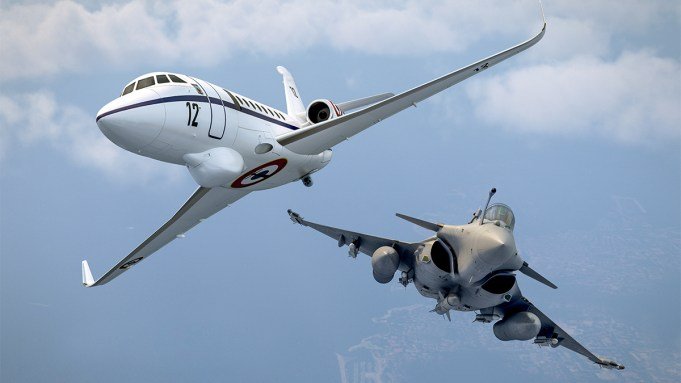How Military Aircraft and Business Jets Are Looking to Each Other for Inspiration

At first glance, private jets and military aircraft couldn’t seem further apart. But in the gray area between coddling luxury and mission-based efficiency, there’s a rich history of innovation exchange that has helped both categories stay on the bleeding edge of aviation.
The trend started in 1909, when the U.S. Army Signal Corps bought a Wright Military Flyer from the Wright brothers for $30,000, and has kept apace for more than a century as dozens of aircraft types were converted for the armed forces. Military-technology transfer is now advancing even more rapidly into the civilian market, with the latest generation of electric aircraft currently undergoing flight testing in preparation for certification in the next few years.
Examples of the technology transfer between military and corporate aviation include Dassault’s Rafale fighter (left) and Falcon 6X business jet (right), which feature similar head-up displays and digital flight control systems.
V. Almansa
The white space tackled by eVTOLs has brought with it the opportunity to invent new flight-control systems for easier, safer operation. “We’d been researching the best way to control a vehicle of this class,” explains Joby Aviation’s Peter Wilson. “We decided that unified controls is a proven direction to go,” he says, referring to systems that allow vertical takeoffs and landings to be executed with one hand. Military programs, including that for the Lockheed-Martin F-35B, had already contributed significant funds to developing the technology, which has since been modified by Joby and rival Archer for eVTOL implementation, with controls that are far smaller for the compact airframes. The advanced systems relay commands every few milliseconds via pilot input to help automate flight, the endgame being a much safer, more intuitive generation of aircraft.
The transfer of aeronautical tech also continues to advance the business-jet world. Take the fly-by-wire hardware that first appeared on General Dynamics’ F-16 fighter. These digital flight control systems (DFCS) allowed for faster and more agile fighter jets and provided more flight consistency than conventional controls. The technology later appeared on the Dassault Mirage 2000, became a primary feature on the Falcon 7X, and is now standard across the Falcon line. Competitors Bombardier and Gulfstream have likewise adopted DFCS for safer cockpits and a more comfortable passenger experience.
Dassault also applied lessons learned from the carbon-fiber wing on its Rafale fighter to its Falcon 10X business jet, which is prepping for flight tests. According to Carlos Brana, Dassault’s executive vice president of civil aircraft, using the carbon-fiber technology saved the company from “starting from scratch” on a new wing design. Brana also cites an example of this same technology flow but in reverse, in which the head-up instrumentation that debuted on the Mercure airliner later trickled up to the Mirage F1 fighter.
Proven track records are key to such applications. “Defense customers [need them] quite quickly, then they stay in service for a long time,” says Steve Patrick, vice president of Bombardier Defense. “A phrase we use quite a lot is ‘capability at the speed of relevance.’” Echoing Brana, Patrick says that “commonalities of supply chain and engineering processes” avoid the need for constant reinvention.

The prototype rendering for a new spy-plane program, this transformed Bombardier Global 6500 is the first business jet used by the U.S. Army in its latest program for targeting enemy communications.
Courtesy of Bombardier
Robust aircraft with system redundancies are military catnip, further evidenced by the fact that the U.S. Army is investing heavily in Bombardier’s Global platform for surveillance missions. The manufacturer’s Global 6500 is powered by Rolls-Royce BR710 turbofan engines that include four standard electrical generators—a configuration that goes above and beyond the standard needs for VIP aircraft. In addition to the excess output, the 6500 has a speed and range that make it attractive to the army because it can be utilized for radar systems, operator workstations, and electro-optical sensors. (The same engine was leveraged for the British Nimrod MRA4 maritime-patrol aircraft.)
The highest-profile example of cross-pollination between the two distinct market segments, though, remains Air Force One: The U.S.-built Boeing 747 adopts secure communications, bespoke cabin entertainment, and an onboard missile-defense system, making it both the most securely protected executive jet in the sky and the most opulent military craft.
Authors
-

Basem Wasef is an automotive and motorcycle journalist and photographer with two coffee-table books to his credit: Legendary Race Cars and Legendary Motorcycles. A contributor to publications…
Read More
Source: Robb Report



